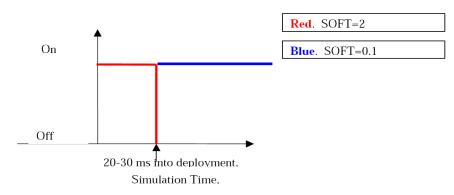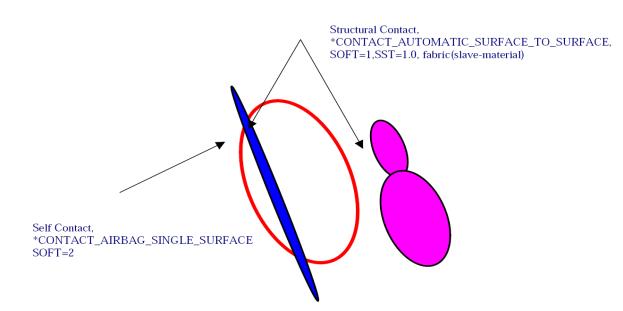Airbag contact
Some of the challenges associated with airbag contact are as follows:
- High Airbag Nodal Velocity (> 100 m/s)
- Soft Tissue Properties ( E < 50 Mpa)
- Small Tissue Thickness ( < 0.5 mm)
- Frequent Initial Penetrations in Folded Bag
- Treatment of Airbag Fabric Layers
To promote stability and accuracy in simulating airbag contact, the following contact types and contact parameters are recommended.
Airbag self-contact
When treating airbag self-contact (fabric-to-fabric contact), the use of *CONTACT_AIRBAG_SINGLE_SURFACE is highly recommended. This contact type is based on *CONTACT_AUTOMATIC_SINGLE_SURFACE but has significant modifications to account for the difficulties associated with deployment of a folded airbag.
SOFT=2 is generally recommended to better deal with the many initial penetrations present in a folded airbag and to invoke a segment-to-segment contact search which is often advantageous in dealing with the complex geometry of a folded or partially unfolded airbag. Airbag contact with SOFT=2 is expensive relative to other contact options so to improve cpu performance when using SOFT=2, an additional contact with SOFT=0 or 1 can be implemented as shown in Figure 8.1. By defining two separate contacts and employing contact birthtime and deathtime to switch from the SOFT=2 contact to the SOFT=1 contact when the bag has unfolded, a good combination of contact reliability and efficiency can be acheived.
If the airbag simulation is run using an MPP executable, note that SOFT=2 is not yet available and so SOFT=0 or 1 must be used. For a folded airbag, this will likely mean that a load curve defining the fabric contact thickness versus time will be necessary to transition from a very small thickness in the folded state to a larger thickness as the bag unfolds. This is done to prevent initial penetrations in the folded state and still have good contact behavior during the unfolding process. The contact thickness vs. time curve is identified by LCIDAB on Optional Card A of *CONTACT. As a possible alternative to a time-dependent contact thickness, the user may try invoking the option for tracking of initial penetrations by setting IGNORE=1 on Optional Card C. This latter option is new in version 960 and has not been thoroughly checked out for airbag applications.
Airbag-to-structure contact
During and after airbag deployment, the airbag fabric comes into contact with other parts of the model such as the steering wheel, occupant, instrument panel, door trim components and, in the case of side curtain 4 deployment, the seat. For these contact conditions, a two-way contact such as *CONTACT_AUTOMATIC_SURFACE_TO_SURFACE is generally recommended. In instances when the airbag nodes comprise the slave side in a one-way type contact such as *CONTACT_AUTOMATIC_NODES_TO_SURFACE, the structural nodes are not checked for penetration through the airbag segments. This may result in noticeable penetration of finely-meshed structural components into airbag segments. Single surface contacts such as *CONTACT_AUTOMATIC_SINGLE_SURFACE for airbag-to-structure interaction may be ill-advised as this would result in duplication of self-contact treatment for the fabric.
Difficulties in airbag-to-structure contact are largely associated with significant differences in material bulk moduli (up to 1000x) and very low thickness of the fabric. To avoid premature nodal release triggered by a small fabric thickness, it is recommended that the contact thickness of the fabric be set to a minimum value of 1.0 mm. Since a wide range of materials are involved, the use of SOFT=1 is highly recommended as it eliminates the need to fine-tune penalty scale factors. An example of the overall setup for airbag-related contact is shown in Figure 2.

Figure 1 Airbag Self Contact Algorithm Switch

Figure 2 Airbag Contact Definition
sb 2001
